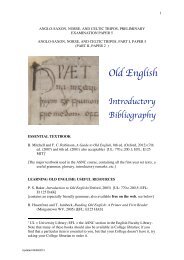Scandinavian history in the Viking age - Department of Anglo-Saxon ...
Scandinavian history in the Viking age - Department of Anglo-Saxon ...
Scandinavian history in the Viking age - Department of Anglo-Saxon ...
Create successful ePaper yourself
Turn your PDF publications into a flip-book with our unique Google optimized e-Paper software.
<strong>Scand<strong>in</strong>avian</strong> History <strong>in</strong> <strong>the</strong> Vik<strong>in</strong>g Age<br />
see (C276); for missionary activity from various directions (L130 ff.); for episcopal organisation (or <strong>the</strong><br />
lack <strong>of</strong> it) (L210 ff.)<br />
For studies on Emund, who reigned around <strong>the</strong> 1050s, <strong>in</strong> particular:<br />
[F96] S. L<strong>in</strong>dqvist, ‘Emund slema och Ingvar vittfaren’, SOS 1968, 74-98<br />
[F97] B. Olrik Frederiksen, ‘Emund slemas navn og rygte’, SAS 10 (1992), 5-24<br />
Early mediaeval Sweden<br />
The development <strong>of</strong> Sweden <strong>in</strong> <strong>the</strong> early mediaeval period is <strong>of</strong> crucial significance, s<strong>in</strong>ce many older<br />
trends can only <strong>the</strong>n be identified; for surveys, see <strong>the</strong> textbooks <strong>in</strong> (A), particularly (A35), and (F1, F8).<br />
[F100] J. Rosén, Svensk historia 1. Tiden före 1718, 2nd edn (1964) [UL 595:1.c.95.8]<br />
On <strong>the</strong> <strong>in</strong>cipient feudal tendencies and <strong>the</strong> development <strong>of</strong> a Swedish ‘state’, cf. (C247) and:<br />
[F101] T. L<strong>in</strong>dkvist, Plundr<strong>in</strong>g, skatter och den feodala statens framväxt: organisatoriska tendenser i<br />
Sverige under övergången från vik<strong>in</strong>gatid till tidig medeltid, 2nd edn (1990) [UL 9002.d.7944] (E.s.)<br />
THE VIKING EXPANSION<br />
G. ICELAND<br />
The settlement <strong>of</strong> Iceland <strong>in</strong> <strong>the</strong> late n<strong>in</strong>th and tenth centuries has proved a treasure-trove for scholars<br />
attempt<strong>in</strong>g to chart <strong>the</strong> development <strong>of</strong> what may be called <strong>the</strong> first new recorded society <strong>in</strong> <strong>history</strong>. The<br />
island has fur<strong>the</strong>r significance as <strong>the</strong> repository <strong>of</strong> <strong>the</strong> collective <strong>Scand<strong>in</strong>avian</strong> historical consciousness,<br />
lead<strong>in</strong>g to <strong>the</strong> composition <strong>of</strong> <strong>the</strong> much-famed sagas (B290 ff., B350 ff.) and <strong>the</strong> preservation <strong>of</strong> Vik<strong>in</strong>g<strong>age</strong><br />
poetry (B480 ff.). For more general surveys <strong>of</strong> <strong>the</strong> whole North Atlantic, see section (H); (H5) is a<br />
particularly useful <strong>in</strong>troduction conta<strong>in</strong><strong>in</strong>g translations <strong>of</strong> many excerpts <strong>of</strong> source material.<br />
General<br />
[G1] J. Jóhannesson, A <strong>history</strong> <strong>of</strong> <strong>the</strong> old Icelandic commonwealth: Íslend<strong>in</strong>ga saga, University <strong>of</strong><br />
Manitoba Icelandic studies 2 (1974) [UL 599:01.c.5.2]<br />
[G2] N.P. Njarðvík, Birth <strong>of</strong> a nation: <strong>the</strong> story <strong>of</strong> <strong>the</strong> Icelandic commonwealth (1978) [UL<br />
599:2.c.95.21]<br />
[G3] B.E. Gels<strong>in</strong>ger, Icelandic enterprise: commerce and economy <strong>in</strong> <strong>the</strong> middle <strong>age</strong>s (1981) [UL<br />
599:2.c.95.22]<br />
[G4] K. Hastrup, Culture and <strong>history</strong> <strong>in</strong> medieval Iceland: an anthropological analysis <strong>of</strong> structure and<br />
change (1985) [UL 599:2.c.95.26]<br />
[G5] J.L. Byock, Medieval Iceland: society, sagas and power (1988; repr. 1993) [UL 599:2.c.95.28, repr.<br />
599:2.c.95.35]<br />
[G6] S. Nordal, Icelandic culture, transl. and rev. V.T. Bjarnar (1990) [UL 599:2.c.95.34]<br />
[G7] G. Pálsson, (ed.), From sagas to society: comparative approaches to early Iceland (1992) [UL<br />
752:37.c.95.40]<br />
[G8] G. Karlsson, ‘A century <strong>of</strong> research on early Icelandic society’, (O72):15-25<br />
[G9] H. Guðmundsson, Um haf <strong>in</strong>nan: vestrænir menn og íslenzk menn<strong>in</strong>g á miðöldum (1997) [UL<br />
592:12.c.95.57]<br />
[G10] O. Véste<strong>in</strong>sson, The Christianization <strong>of</strong> Iceland: priests, power, and social change, 1000-1300<br />
(2000) [UL 62:56.c.200.1]<br />
[G11] J. L. Byock, Vik<strong>in</strong>g <strong>age</strong> Iceland (2001) [ASNC]<br />
[G12] P. Meulengracht Sørensen, ‘Social <strong>in</strong>stitutions and belief systems <strong>of</strong> medieval Iceland (c. 870-<br />
1400) and <strong>the</strong>ir relations to literary production’, (B235):8-29<br />
[G13] J. Qu<strong>in</strong>n, ‘From orality to literacy <strong>in</strong> medieval Iceland’, (B235):30-60<br />
The archaeological record<br />
The material culture <strong>of</strong> Iceland is heavily based on <strong>Scand<strong>in</strong>avian</strong>, particularly Norwegian, models.<br />
85






